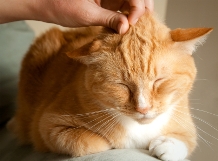Feline Hypertension
 The medical term for high blood pressure is hypertension.
The medical term for high blood pressure is hypertension.
Causes of High Blood Pressure in Cats
Hypertension occurs most commonly in older cats and is usually associated with another illness such as chronic renal failure (kidney disease) or hyperthyroidism (overactive thyroid).
Hyperthyroidism usually has a moderate effect on blood pressure, which can resolve with treatment of the thyroid condition. When kidney disease and hypertension are present together, the hypertension tends to be more severe and usually requires specific treatment. Sometimes, hyperthyroidism and kidney disease are both present, and this presents a special challenge for therapy.
Hypertension is very damaging to a cat’s body. High blood pressure causes small blood vessels to leak or even rupture. This is especially important in delicate tissues like the eye (leading to detached retina and blindness) or the brain (resulting in stroke = cerebral vascular accidents). Hypertension also increases wear and tear on the kidneys and the heart, compounding problems for cats with kidney or thyroid disease. Early detection is important to prevent these complications.
Signs of Feline Hypertension
High blood pressure by itself has no early signs. Instead, the signs noticed are those of the underlying disease. In the case of kidney or thyroid disease, these may include increased thirst, vomiting, appetite changes, and weight loss. Clues your veterinarian may find on a routine physical examination may include a new heart murmur or changes inside the eye.
When signs do occur, they are sudden and dramatic. Acute blindness is the most common. Tiny blood vessels in the inner lining of the eye burst, causing the retina to detach. Loss of vision may be partial or complete. The affected patient may be disoriented, unwilling to walk or move, and the pupils are usually dilated. A less common but serious situation occurs when there is bleeding in the brain. The signs of this may include disorientation, head tilt, trouble walking, or seizures. Hypertension causing blindness or behavior changes is a medical emergency.
Diagnosis of High Blood Pressure in Cats
In times past, few veterinarians were equipped to measure a cat’s blood pressure in the office. Most cats were diagnosed with high blood pressure because they suddenly went blind. Now, most veterinarians know when to suspect hypertension and can test for it before a crisis occurs. Routine wellness visits are essential to help diagnose this and other problems in a timely fashion.
A cat’s blood pressure is measured much the way it is in people, most commonly using an inflatable cuff and a listening device called a Doppler. The cuff may be applied to a front leg, back leg, or the tail. The procedure takes just a few minutes and is completely painless for your cat.
Taking the measurements is fairly easy. Interpreting the results is another matter. Some cats are very nervous in the vet’s office, and this can have a big effect on their blood pressure. A series of readings is usually taken, and increased accuracy is found when there is time allowed to relax the cat before taking the readings, by letting a client hold and talk to their cat, or even by repeating the test on a few different days.
Treatment for Feline Hypertension
When hypertension is diagnosed before serious complications occur, the first step is to address the underlying disease. Then the patient may be put on an oral blood pressure medicine. Frequent visits are required while the dose is adjusted. Blood pressure medication is very potent and is dosed in small increments, so it’s important to follow directions carefully. An additional medication is sometimes added to get the balance just right. A low-salt diet is sometimes recommended.
Cats in a hypertensive crisis must be admitted to the hospital for intravenous and other medication and careful monitoring over a few days. Where available, this will be done in a hospital that offers 24-hour critical care and an experienced staff.
Will My Cat with High Blood Pressure Be OK?
The outlook for cats with hypertension depends mostly on the type and severity of the underlying disease. Hyperthyroidism is generally treatable, whereas chronic kidney failure progresses over time, presenting other complications.
For cats with acute onset of blindness, as many as a half may regain some vision if treated promptly. The outlook for cats that have had a stroke is more variable. Each patient is unique, so for specific concerns about hypertension and your cat, be sure to consult your veterinarian.
You May Also Like These Articles:
Flame Retardants and Hyperthyroidism in Cats
Saddle Thrombus: Aortic Blood Clots in Cats
Notice: Ask-a-Vet is an affiliated service for those who wish to speak with a veterinary professional about their pet's specific condition. Initially, a bot will ask questions to determine the general nature of your concern. Then, you will be transferred to a human. There is a charge for the service if you choose to connect to a veterinarian. Ask-a-Vet is not manned by the staff or owners of CatHealth.com, and the advice given should not delay or replace a visit to your veterinarian.





